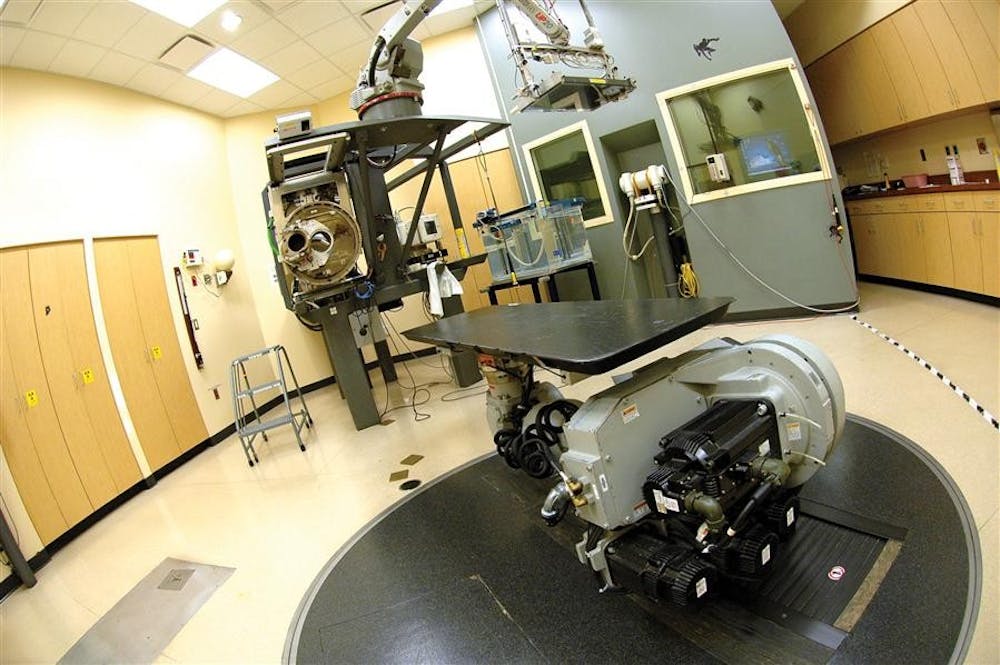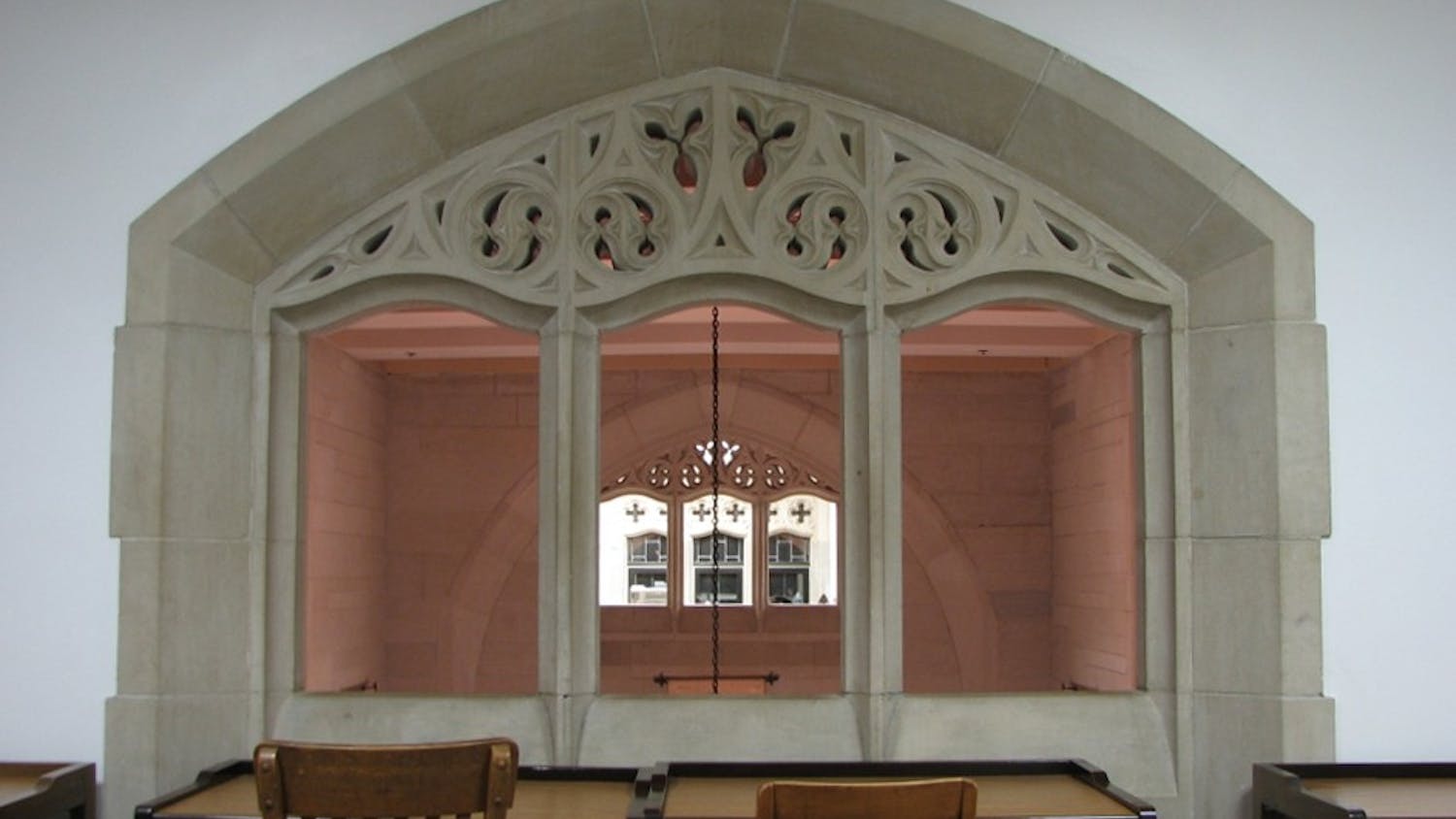Wishing only to fulfill graduation requirements, history or political science majors might begrudgingly take an introductory-level physics course. As they sit in lecture in Swain Hall West, coloring in the “o’s” of words such as “torque” and “force” on notebook paper, they might prefer to learn about something they believe to be more pertinent to society and people. The Cold War, maybe. Or the Manhattan Project.
What these doodling non-majors don’t know is that they sit on the crater of a war machine. In the belly of Swain Hall West once sat a cyclotron, an instrument that collected data to build Little Boy and Fat Man, atom bombs that the United States dropped on Hiroshima and Nagasaki during World War II. Inside the cyclotron, sub-atomic particles whirled around in a spiral path, propelled by great magnets to a cataclysmic end.
Any world-history class can teach the results of cyclotron research: the loss of 200,000 Japanese lives and the end of the war.
The historic destruction of Hiroshima is separated from IU by thousands of miles and more than 60 years, but time and distance won’t break the connection. Instead of leaving the machine to rust in infamy, the cyclotron was transformed from battle machine to a precision cancer81 treatment. Cutting-edge cancer treatment is presumed to have a home only in places such as the Mayo Clinic, Harvard, and Stanford, but one machine has forever carved Bloomington’s name in the annals of both war and medical history, as the legacy of the cyclotron is rewritten.
*****
It’s mid-October in Bloomington, and the IU Department of Physics has scheduled its open house weekend around one of the cyclotron’s quarterly maintenance shutdowns. Although there are many safety measures already in place, public viewing of the facility is limited to these shutdown periods to reduce radiation exposure. Driving down Milo B. Sampson Lane, the Midwest Proton Radiotherapy Institute is nestled just past the IU Cyclotron Facility facade. The lobby is warm and welcoming, with overstuffed chairs, children’s toys, and a fish aquarium. To the right is a set of double doors, through which all patients pass before receiving treatment.
The doors give way to a brightly lit hallway with rooms lining its sides. This is the patient’s first real encounter with the facility. There are five exam rooms, four for adults and the other for children. The pediatric room’s walls are covered entirely by a mural depicting a greenscape of flowers and birds; at the head of the exam table is a painted teddy bear in a doctor’s uniform.
A local film crew has come this morning to interview Allan Thornton, MPRI’s medical director since 2002 and a well-respected figure in radiation oncology. The crew questions him about the significance of proton therapy for Monroe County, and to catch a glimpse of the cyclotron during its shutdown period. Thornton walks in wearing a pressed pinstripe suit, just late enough to arouse a flurry of concern.
Once the interview begins, it is clear he is accustomed to speaking about his work. Proton therapy for cancer treatment is no less powerful than conventional X-ray therapy, he says. It’s simply more precise. It allows a group of specialists to target a tumor within 1 millimeter. X-rays, by contrast, have a much looser target, which can affect the surrounding, healthy tissue. Proton beams wield such control because of something called the Bragg peak, a sharp stopping point of the proton beam. Proton therapy offers a kind of accuracy that makes it an ideal form of cancer treatment for children, whose tumors are imbedded in growing tissue, and for patients with tumors in the head or around critical organs.
Many patients may be implanted with tiny BB-like balls around the treatment area, markers to position the patient. They remain in the body even after the proton therapy is completed. Phil Thompson, an early patient of MPRI, was implanted with solid gold BBs in his prostate. As he was undergoing treatment, his friends drafted and notarized a document saying if, for whatever reason, Thompson’s wife were to outlive him, she would have an autopsy performed on him to obtain the gold BBs and have them fashioned into a necklace and earrings.
Thompson is closer to the machine than most. He worked for years as a technician on the same cyclotron that extended his life.
Thompson’s upbeat attitude and sense of humor are infectious, and he’s putting it to good use. After his own recovery, he had a strong impulse to help those going through the same rough patch of road. Feeling blessed to have his family and friends at his side during the treatment, he was compelled to give that same support to patients who are far from loved ones. After seeing some of his fellow patients suffer from loneliness, he was inspired to start Hoosiers Care, a non-proselytizing organization fueled to make patients feel more comfortable during their stay in Bloomington. People have donated money, time, and even condos to the project.
****
The walls of Thompson’s office are plastered with photographs of former patients with whom he developed relationships. He has a dozen stories for each face, and each of those faces has gazed with dismay into the nozzle of the proton beam.
The machine has spurred both fear and healing. The patients treated at MPRI have been healed by hydrogen ions launched by IU’s original cyclotron.
In 1938, shortly after becoming the president of IU, Herman B Wells agreed to fund the construction of the University’s first cyclotron. Wells wanted the physics department to surge ahead as a frontrunner of scientific research. The department’s work eventually assisted the Manhattan Project’s drive toward building the ultimate weapon.
With the intention of molding the physics program into a world-class academic arena, Wells hired Milo Sampson, Daniel Miller, and Lawrence Langer, all of whom were prominent physicists at the time. It’s Langer, though, who was the most intriguing figure of the group. Having been named the physics department chair, he was also working for the Manhattan Project. Legend has it84 that the night before deployment in 1945, Langer slept on one of the bombs destined for Japan to prevent tampering.
Work on the cyclotron continued for decades, until researchers set their sights on the implementation of another powerful tool. The National Science Foundation granted funding, and in 1968, the old cyclotron was decommissioned to make way for the new, more powerful 200 mega-electron-volt cyclotron. That same year, Phil Thompson joined the staff as a cyclotron technician, though he had no experience in physics.
“At that time, I was a generalist,” he says. “I was a jack of all trades and master of none. I could do ... you name it. They were looking for someone who had a myriad of skills to be a technician. Not even knowing what a cyclotron was, I was hired.”
Thompson eventually became assistant to the director of the facility, and worked on the machine through its transitions. The small cyclotron was moved from Swain Hall West to the IUCF’s current home north of Memorial Stadium, and refurbished to serve as an injector cyclotron for a larger, more modern partner. Together, the two accelerators85 sent particles shooting at nearly the speed of light.
Building the new facility was a dangerous job. Managing such heavy objects and high voltages was careful, tiring work. One man, Thompson says, was severely injured after taking a nasty fall into the main stage cavity of the concrete floor. By fall 1975, the construction ended, and the cyclotron siblings were set to operate. For 25 years, the center functioned as a highly esteemed medium-energy nuclear physics laboratory.
****
Technology86 is cannibalistic by nature: The new consumes the old. The IU Cyclotron Facility was eclipsed by more sophisticated machines, such as the Tevatron at Fermilab, near Chicago. And, since the IU cyclotron clocked in at the relatively low energy of 208 MeV, it could no longer compete in nuclear-physics research.
In 1987, John Cameron was appointed the director of IUCF. He was a motivating force in ushering the facility toward its new role, aware of its looming obsolescence. He had learned about proton therapy at the University of Alberta. In Canada, proton therapy became increasingly commonplace as a method of cancer treatment. The IUCF was a good candidate for proton therapy due to the cyclotron’s lower-energy beam, which was just strong enough to penetrate halfway through the average human body.
“This is perfect for humans. You only need to penetrate halfway through because you can just turn the patient around to get the other side,” Susan Klein says, cutting right past physics jargon. Klein has been a medical physicist at IUCF for more than 15 years, and has witnessed many of the hurdles it has faced during her tenure.
When Klein joined the staff, Cameron was garnering enough support and funding to develop IUCF’s role as an institution devoted to medical innovation. In 1993, a young man suffering from an aggressive, inoperable brain tumor became the facility’s first patient to receive the proton therapy. Klein says that at the time, “everything was very rudimentary.”
The progress could not have come at a better time. By 1998, the funding from the National Science Foundation for the had cyclotron ran out, and IUCF needed to change gears or close its doors. In response to the dilemma was the construction of the MPRI , now one of only five such clinics in the nation.
Though it saved the cyclotron’s operation, the shift was not without its opponents. Many doctors and administrators were adamantly opposed to proton therapy. Those against it indicated that its effectiveness had yet to be officially proven because it never underwent a double-blind study. Klein says such a study would not be useful because the technology is constantly changing. “It’s a moving target,” she says.
Despite doubts of the proton therapy’s supposed benefits, there were two men who showed tremendous faith in the technology. One was Thompson, the other, Cameron. But when both developed prostate cancer in 2004, and they each chose proton therapy as their preferred method of treatment. The timing of their treatments overlapped, and the two men shared in the experience of moving from behind the scenes of the cyclotron to the target of the beam. There are photos of the pair dancing together in the foyer of MPRI, dressed only in hospital gowns, Cameron says.
In both cases, the cancer was sent into remission and has not returned, thanks to the protons whirling around inside the cyclotron, hurled by magnets guiding them to their proper place.
“It’s been a journey,” Thompson says, reflecting on the way events in his life have unfolded. “It’s been very interesting--it’s not over yet, either.”
Of hope and light
IU's war machine finds a new legacy in lifesaving cancer treatment.

Get stories like this in your inbox
Subscribe





